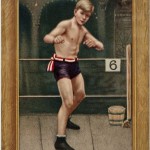The Fine Arts Library recently purchased a copy of one of the earliest Jean Tinguely exhibition catalogues, his show at the Museum Haus Lange in Krefeld, Germany, September – October, 1960.
This small show came hard upon Tinguely’s earliest (and perhaps greatest) success, the debut of his “metamatic” or self-destructing machine Hommage to New York at the Museum of Modern Art that spring. The catalogue which accompanied the show in Krefeld consists of a black paper folder with the dates, credits, and colophon (our copy is numbered 230 in yellow crayon), with a quarto folded sheet of photographs of the artist at work and works in situ and two ‘metamatic’ paintings, each signed by Tinguely in ink.




